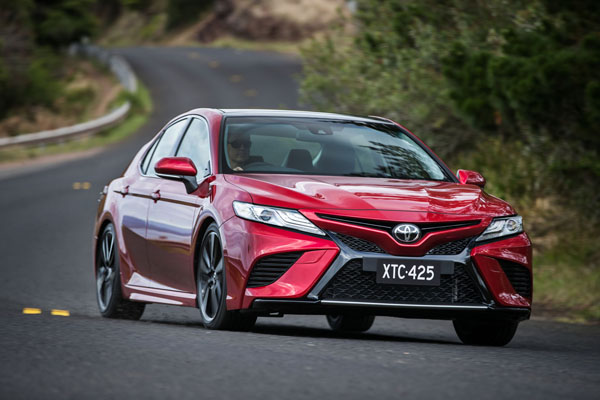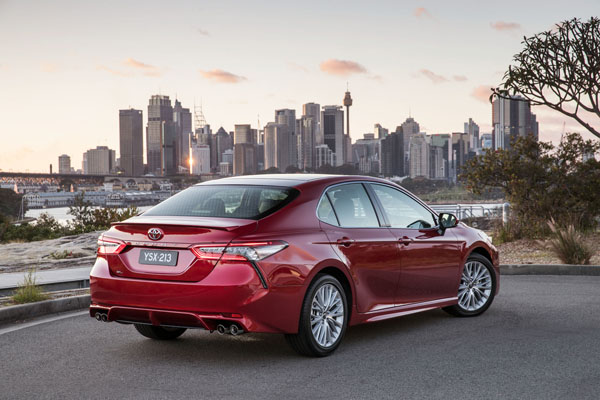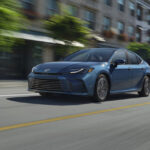 The end of the Australian automobile construction industry over the past 18 months is likely to have differing effects on each of the three affected companies. Ford has bitten the bullet and discontinued the Falcon while Holden is gambling on its loyal buyers moving to a German-built Commodore.
The end of the Australian automobile construction industry over the past 18 months is likely to have differing effects on each of the three affected companies. Ford has bitten the bullet and discontinued the Falcon while Holden is gambling on its loyal buyers moving to a German-built Commodore.
By contrast the switch from locally-produced to imported Toyota Camrys is likely to be seamless given our feeling that a fair proportion of current owners aren’t even aware that their car was built at the company’s Altona, Melbourne plant. New Camry comes from Toyota’s Tsutsumi plant near Nagoya in Japan.
The 2018 Camry is the first sedan to be built on the new Toyota New Global Architecture (TNGA) one that we saw most recently in the CH-R compact SUV. TNGA allows the sharing of parts and components among many vehicles across the Toyota range.
In the Camry it allows the car to sit a little bit lower and wider and provide a lower centre of gravity. This together with a more rigid chassis and enhancements to the car’s suspension and steering combine to provide a significant improvement in the car’s driving dynamics.
New model names have been introduced. In ascending order of equipment they are Ascent, Ascent Sport, SX and SL. All but the SX come with the option of hybrid power while the SX and SL are available with V6 petrol engines. The Camry name is now used for all variants with the previous Toyota Aurion tag used for the V6 being dropped.
Prices have been reduced for six of the nine new Camry variants while increases on the other three are more than compensated by extra features.
STYLING
Camry has long been seen as a conservative car and its 24-year dominance of the mid-sized passenger market suggests that buyers like it like that. So it comes as a bit of a surprise to see a much sportier look to the new model especially in the higher grade models.
The front features two-piece grilles with contrasting designs – refined and relatively conservative for Ascent, more aggressive and sportier for Ascent Sport, SX and SL.
Wheel sizes range from 17-inch in the Ascent and Ascent Sport to 19-inch in the SX, then back down to 18-inch in the SL. Ascent has a full-size spare wheel, all others get a space saver.
The petrol-only SL has a panoramic sunroof while the SL Hybrid uses an electric tilt-and-slide moonroof.
INTERIOR
A larger windscreen and lower waistline give an airy feel. The new dynamic look continues with an asymmetrical dashboard.
The dashboard, instrument panel, centre console and door trims use soft touch materials with a mix of colours.
Boot size is 493 litres in the Ascent with its full-size spare and 524 litres in the other models including the hybrid variants.
ENGINES / TRANSMISSIONS
New Camry engines come with the same capacities as the superseded models, but have been revised. Outputs from the 2.5-litre four-cylinder petrol unit are marginally down to 133 kW of power and 231 Nm but significantly up in both the 2.5-litre hybrid and V6 engines.
The revised engine and hybrid system provide an extra 15 kW and 18 Nm (to 118 kW and 213 Nm) while the new V6 adds 24 kW and 26 Nm (to 224 kW and 362 Nm).
Fuel consumption is down by around 6.5 per cent for the V6 and between 13.5 per cent and 19 cent in the various hybrids. That of the petrol only four-cylinder is effectively unchanged.
Each engine gets a different transmission, all automatics of course. The 2.5-litre petrol automatic is mated to a conventional six-speed; the hybrid to a CVT; with the V6 having an eight-speed. There are paddle shifters on the SX and SL models.
INFOTAINMENT
Vehicle information is displayed on a 4.1-inch multi-information display (MID) and 7-inch (Ascent) or 8-inch (higher spec models) touchscreen that uses the Toyota Link multimedia system synced by smartphone via Bluetooth to access a variety of apps and services. Apple Car Play and Android Auto are not available.
Camry Ascent Sport and above get satellite navigation while SX and SL also have a wireless phone charger located in the central console which, although handy, it does take up some otherwise useful storage space.
SAFETY
Standard across the new Camry range are seven airbags; enhanced ABS brakes; pre-collision safety system; autonomous emergency braking; lane departure alert with steering assist; active cruise control; automatic high beam; hill-start assist; trailer sway control; reversing camera; LED headlights and LED daytime running lights.
The top spec SL adds blind-spot monitoring; rear cross-traffic alert; rain-sensing wipers: head-up display; and electro-chromatic interior rear-view mirror while the three higher grades have front and rear parking sensors.
The inclusion of autonomous emergency braking and lane departure alert across the new Camry range ensures that it gets a five-star ANCAP safety rating.
DRIVING
We’ll be doing an extended two-week test on the new Camry Hybrid shortly so will concentrate on our test of the petrol 2.5-litre SL here.
New Camry’s lower height doesn’t affect interior space because the seats are now lower, bucking the trend of a higher seating position that is one of the major attractions of SUVs.
Many people above 1.8 metres may need to set the seat to its lowest setting to avoid scraping against the roof, especially in the SL with its sunroof. Once inside and settled the seats are comfortable and supportive.
The four-cylinder engine is quiet, refined and responsive with more than enough performance for most buyers. For those looking for extra the V6 is on offer.
Steering is well weighted and provides more driver feedback than before. Ride comfort is very good, even on coarse-chip and corrugated surfaces. Noise levels are well suppressed and will make for refined long distance cruising.
Fuel consumption during our week-long test averaged out at 9.2 litres per 100 kilometres, around the typical 10 per cent margin above Toyota’s factory tested number.
SUMMING UP
Toyota has clearly ignored the “if it ain’t broke don’t fix it” adage with its decision to add a more sporty dimension to Camry.
The significant improvements in both the looks and performance of new Camry are sure to appeal to the keen private buyer who wants a comfortable commuter that can be taken for some fun weekend driving.
AT A GLANCE
MODEL RANGE
Ascent 2.5-litre petrol four-door sedan: $27,690
Ascent Hybrid 2.5-litre petrol / electric four-door sedan: $29,990
Ascent Sport 2.5-litre petrol four-door sedan: $29,990
Ascent Sport Hybrid 2.5-litre petrol / electric four-door sedan: $31,990
SX 2.5-litre petrol four-door sedan: $33,290
SL 2.5-litre petrol four-door sedan: $39,990
SL Hybrid 2.5-litre petrol / electric four-door sedan: $40,990
SX 3.5-litre V6 petrol four-door sedan: $37,290
SL 3.5-litre V6 petrol four-door sedan: $43,290
Note: These prices do not include government or dealer delivery charges. Contact your local Toyota dealer for drive-away prices.
SPECIFICATIONS (Toyota Camry SL 2.5-litre petrol four-door sedan)
ENGINE:
Capacity: 2.494 litres
Configuration: Four cylinders in line
Maximum Power: 133 kW @ 6000 rpm
Maximum Torque: 231 Nm @ 4100 rpm
Fuel Type: Petrol 91RON
Combined Fuel Cycle (ADR 81/02): 8.3 L/100km
CO2 Emissions: 181 G/KM
DRIVELINE: Six-speed automatic
DIMENSIONS, WEIGHT AND CAPACITIES:
Length: 4905 mm
Wheelbase: 2825 mm
Width: 1840 mm
Height: 1445 mm
Turning Circle: 12.4 metres
Kerb Mass: 1505 kg
Fuel Tank Capacity: 60 litres
BRAKES:
Front: Ventilated disc
Rear: Solid disc
STANDARD WARRANTY:
Three years / 100,000 kilometres












